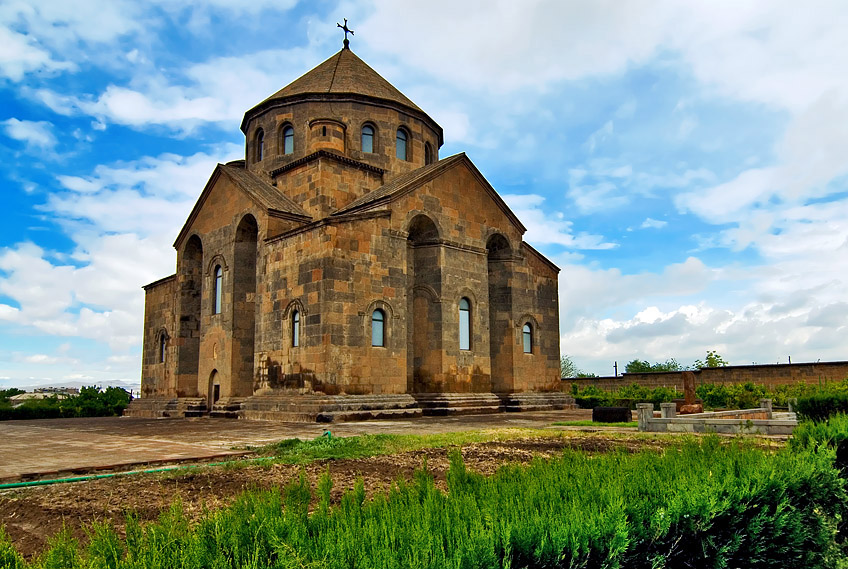Saint Hripsimé Church (Armenian: Սուրբ Հռիփսիմե եկեղեցի) is one of the oldest surviving churches in Armenia. The church was erected by Catholicos Komitas atop the original mausoleum built by Catholicos Sahak the Great in 395 AD that contained the remains of the martyred Saint Hripsimé to whom the church was dedicated. The structure was completed in 618 AD. It is known for its fine Armenian-style architecture of the classical period, which has influenced many other Armenian churches since. This church together with other nearby sites is a UNESCO World Heritage Site, and is located in the present day city of Vagharshapat, (Etchmiadzin), Armenia in the Armavir Province.
History
Saint Hripsimé Church sits on the remains of a pagan structure and also the site where the aforementioned saint was martyred during the time of the conversion of Armenia to Christianity in 301 AD. The fifth century Armenian historian Agathangelos wrote that the young and beautiful Hripsimé who at the time was a Christian nun in Rome, was to be forcefully married to the Roman emperor Diocletian. She and the abbess Gayané among other nuns fled the tyrant emperor and left to Armenia. The pagan Armenian King Trdat received a letter from Diocletian in which he described her beauty. Trdat discovered where the nuns were hiding, and fell in love with Hripsimé and later Gayané. After her refusal of his advances, Hripsimé was tortured and martyred at the location of this church, while Gayané was tortured and martyred at a separate location where the church in her name was later built in 630. The remaining group of thirty-eight unnamed nuns were martyred at the location of Shoghakat. During the time that Hripsimé was being tortured, Gayané told her to "be of good cheer, and stand firm" in her faith. King Trdat was to be later converted to Christianity and made it the official religion of the kingdom.
In the early 4th century, Saint Gregory the Illuminator saw a vision in which Christ descended from the heavens, and struck the ground with a golden hammer to level it. In its place he saw the site where Hripsimé was martyred, with a red base symbolizing blood below "columns of clouds, capitals of fire, and on top, a cross of light." In the vision, Christ tells him to erect a memorial to Hripsme in the given place. Saint Gregory was designated to set out the foundations at the location where Hripsimé had been martyred.
Architecture
Two inscriptions, one on the western façade and one on the east apse as well as an account from the Armenian historian Sebeos of the 7th century both date the church and mention Catholicos Komitas as having commissioned it to be built. As mentioned earlier, the church was built upon the 4th century Mausoleum of Saint Hripsimé, depicted in a relief upon the south face of the 7th century Odzun Stele.
The Church of Saint Hripsimé has a square tetraconch highly complex central plan rather than the typically seen rectangular plan. The structure has withstood numerous earthquakes due to many aspects that give it strength and stability. In the walls niches were used to increase the building's resistance to collapse. The dome supports are equidistant and are able to hold a balanced share of the weight, leaving the squinches less liable to crack or break during an earthquake. Twelve ribs reinforce the dome, enabling it to be constructed of a lighter and thinner material.
It has undergone several changes since it was first built. According to the 17th century Armenian historian Arakel of Tabriz, the church was renovated between the years 1651-1653 by Catholicos Philippos. Repairs were made on the roof, top of the dome, the walls and bases. A cross was placed on top of the roof, and a small portico was added to the church's west side. The western and southern entrance gates to the church precincts were closed, and the two side windows of the altar apse have been walled up. The eastern apse originally had only one window, and later two supplementary windows were added due to Chalcedonian tendencies among church leaders. In the interior, the Bema, the floor, the four apses were repaired, and the walls were covered in plaster. In 1790 a two-tier bell tower with an eight-column belfry was added. Later in 1936, the foundations were strengthened. In 1959-1962 renovations were done on the outside courtyard and steps and on the interior. The floor was lowered and 17th century plasterwork was removed to reveal a system of eight large and sixteen small squinches under the circular drum.
In the interior of the church, of particular interest is the inlaid mother-of-pearl altarpiece of 1741, which demonstrates the high level of Armenian applied art of the 18th century. The composition of the ornament made up of framed interwoven branches with stylized leaves and various fruit and blooms, is arranged around an encircled Greek cross and is most original.
The graves of two 18th century Armenian Catholicoi are located in the church's courtyard, those of Asdvadzadur and Garabed II.

fonte: @edisonmariotti #edisonmariotti colaboração


Nenhum comentário:
Postar um comentário